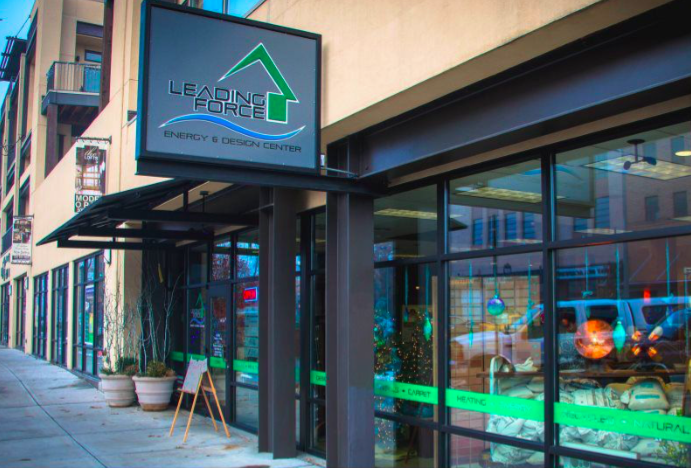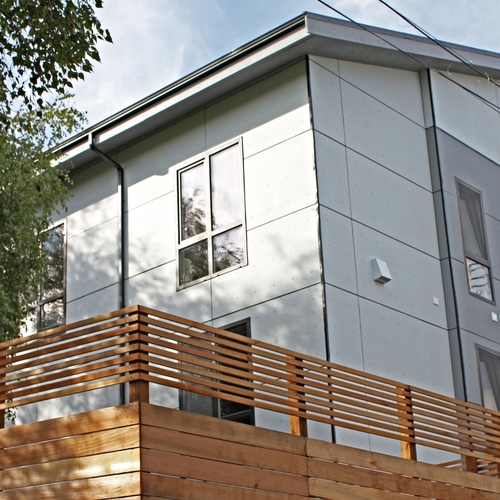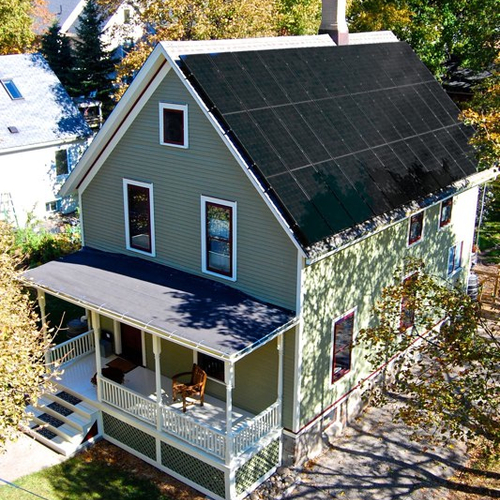
Steve Weise is trying to move the needle. A seasoned builder, first-time developer, and owner of Leading Force Energy & Design Center based in Yakima, Washington, he finds himself in the role of educator more often than not. He describes the region in which he lives and works as having an agricultural history and its demographic as “less educated on the benefits of healthy materials and design.” Therein lies his struggle. “Yakima builders are not sold on the idea that green building is important,” he says. “It’s really code-driven.”

Part of the impetus for opening the 2500-sq.-ft. design center was the fact that Weise was having a hard time sourcing local, sustainable, and healthy materials; he had to trek to Seattle to find them, and he wanted the same availability in Yakima county. Today, the firm is a resource for finding both green building professionals and products that range from cabinetry to flooring, lighting, sound technology, air-sealing supplies, and beyond. The team of designers and tradespeople specializes in the design/build of energy-smart homes, and it offers professional education sessions on energy efficiency and code. “The collaborative model is a way to provide integrative design on a smaller scale,” says Terry Phelan, principal of Living Shelter Architects and an early member of the team.
Setting the stage for future development
Leading Force’s latest and most ambitious undertaking, Selah Vista Homes, is a 60-home Built Green 5-Star neighborhood development set on a 16 acres. (The project received the 2018 Department of Energy Housing Innovation Award for spec-built houses.) There are five phases of development slated, the first of which calls for 20 new homes. Currently, eight have been built and 13 lots have sold. Weise anticipates selling all lots in three years, and having them built out in five.…
Weekly Newsletter
Get building science and energy efficiency advice, plus special offers, in your inbox.

This article is only available to GBA Prime Members
Sign up for a free trial and get instant access to this article as well as GBA’s complete library of premium articles and construction details.
Start Free TrialAlready a member? Log in










22 Comments
"For daisy chain electrical wiring, he drops the lines from the ceiling so electricity is out of the field of a sleeping person’s brain waves. In some cases, he includes a single switch to turn off all electricity in a room. He explains: “If a person’s head is within proximity of electrons flowing through wires, the science shows disruption in brain waves, which interrupts sleep.”
" when cellulose runs short on supply, it is substituted with cellulose from sources that use a lot of ink, which can be toxic. “He has seen the cellulose industry create havoc,” Weiss explains. “And paper requires some use of fungicide to prevent mold."
If statements like these are going to make their way into a GBA article they need either a disclaimer or some more supporting documentation.
I've been using cellulose a long, long time and am yet to see cellulose "wreak havoc" on anything. I've only seen the exact opposite.
While that is a pretty bold statement to make, it is equally important to note from where it came: an insulation industry rep whose listed sponsors on their website are Demilec, Owens Corning, Dow, CertainTeed...and on and on.
Hi Malcolm, I tend to agree with you. It's easy to make crap up these days.
Regarding EMF, about 10 years ago I attended a retreat for the NorthWest EcoBuilding Guild. While there I attended a session on EMF taught by a couple of 30 something scientists. Quite frankly, afterwards, I didn't know what to think. So like most things in life that I'm curious about, I googled it and found more information than I could imagine. Even though it remains a controversial topic I have had to address it for several of my clients and potential clients and personally, I would rather error on safety for my clients. Here are a couple of articles I found on line as a starter for the curious reader:
ttps://www.who.int/peh-emf/about/WhatisEMF/en/index1.html
https://blog.designsforhealth.com/node/887
Regarding Cellulose, I am not an expert which is why I rely on one of my team members, Don Jordan, for insulation advice. Don has been a member of Insulate America for over 2 decades. Years ago Don stopped using Cellulose claiming that even though he was buying from non toxic sources he found that his suppliers during peak demands would substitute product that had ink and fungicides in it. I personally steer away from cellulose because of the difficulty I have had in trying to retrofit technology or lighting controls in the walls. Fiberglass can be a controversial product to an environmentalist but given that I am focused at moving traditional builders to a higher standard of health and energy I found it one of those trade offs that I'm willing to make. Setting all my personal experience and reasons aside, the customer is in charge of product, If a client wants me to resource more sustainable materials I will certainly give a client what they want.
Steve,
It's entirely up to you how you want to build, and what values you find important to address. I'm more concerned with the journalism than whether you choose to wire your houses in ways you think minimize EMFs, or consider cellulose insulation toxic. The article should have been made clear these are certainly not views commonly held by building scientists, and or mainstream medicine.
Malcolm,
As the journalist here, I'd like to point out that I am quoting my source with impartiality and sharing his approach. There is no suggestion that these are commonly held beliefs or practices among those in the green building industry. In fact, the point of the piece is to show how Steve is going against the grain.
Kiley,
Lets look at the two excerpts I posted.
If the section on EMFs had started "Weiss believes he has seen enough compelling evidence of the dangers of EMF pollution that it needs mitigating" I wouldn't have commented. But the phrase "The science shows" has a very specific meaning. It is reserved for topics where there is widespread consensus and agreement. That's not the case. That the magnetic fields generated by household electrical service has any effect on the occupants is a fringe belief. When journalists deal with those types of subjects they have an obligation to not just present the material impartially, but to put it in some context.
Cellulose is dismissed on two main grounds: The first is It can contain excessive ink "which can be toxic" and has fire retardant in it. This needs to be more than a bald assertion. It needs to be fleshed out. Are the inks and fire retardants in cellulose "toxic", and what are the mechanisms that could spread these "toxins" to the inhabitants? The second reason, that his colleague has "seen the cellulose industry create havoc" has no useful content. It's like saying "I always drive a Chevy because my uncle says Fords are a mess".
So why did I bring all this up? Because GBA is somewhere that readers come for information they use to make decisions about how they will build, what materials to use, and what are the important things they need to address. The tradition that Martin created was to give them fact-based articles to do that.
Re: your first point: It was a direct quote.
Re: your second point: I worked hard to get Don on the phone to help me flesh this out, as these are his thoughts on cellulose as shared by Steve.
That said, I take your point. And I hope you see the point being made with this article. It is a concept piece, not meant to encourage builders to use this or that material. It's about Steve's approach, as he shared it with me.
Steve,
Like Malcolm, I see no evidence that "the cellulose industry has created havoc." Any GBA readers who want science-based information on EMFs might want to read this article: "EMFs and Human Health."
I wanted to hear more about that too. I contacted Don for comment multiple times, to no avail.
If the EMF was of such concern, did anybody bother to measure it? I'm guessing not, but if yes, what was the max "acceptable" value, and where did the measurements come in, under what levels of electric load/current?
Having dealt with electromagnetic interference issue with sensitive electronics from sub 10 hertz into the microwave spectrum I'm pretty dubious about the ability of the average electrician or architect/builder to understand and implement an ultra low frequency EMF mitigation strategy with the wiring.
Induction cooktops, anyone? :-)
The kind of RF crap coming off the power supplies of your computer, laptop, or cell phone (and charger) are probably more "interesting" from a biological interaction perspective, but the there isn't clear enough science on whether the measured levels are high enough to develop a rational regulation around it. At a high enough field intensity all sorts of stuff can happen. But just as walking in the sunshine for 10 minutes isn't particularly hazardous (and is even be beneficial for health), low level EMFs in the sub 1000Hz range at the field strengths found in homes aren't likely to have much effect one way or the other. There has been a whole industry developed out of scaremongering around the subject though.
But there is good news- now that very conductive graphene fibers are available, in short years you will no longer need to line your hat with foil! :-)
This is Terry, the lead architect on the project. As Steve mentioned, some of our clients have concerns and sensitivities that we are called on to design around. To many, these are as real as chemical sensitivities (which are very much a concern in 'standard' building practices) and our job is to create a safe harbor from both.
Steve had the vision to create a community where these people are heard and taken care of. BTW, our clients that fit into this demographic also limit their exposure to computers and cell phones, and ask for shielded hardwire rather than wireless connections. Great question about induction cooktops - I am interested in learning if any manufacturers are addressing shielding on these.
Terry,
You post confuses me a bit. Are you saying that these building assemblies are also designed for the chemically sensitive?
There isn't a lot of detail in the article, but from the photos and building section it would appear that the exterior sheathing is the primary air-barrier. That leaves the closed cell foam, fiberglass batts, and finger-jointed studs within the conditioned space. It also looks like some of the plumbing fixtures, drains and supply lines are plastic. Can you elaborate a bit on how the exposure to chemicals are mitigated while using these materials?
It sounds to me like Terry is diplomatically saying that for people who are sensitive to EMF, it's as real to them as MCS, or multiple chemical sensitivity, is to those who are chemically sensitive--an affliction that is easier to "prove" is real than EMF sensitivity. MCS is often lumped with EMF and mold sensitivity as "woo-woo," not something to be concerned with, because most of the population is not affected.
What's the harm in putting some effort into making those who are EMF-sensitive happy? I've designed plenty of things for clients that I thought were odd but that were important to them. Most of my clients think an attached master bathroom is a bare necessity of life. Others can't conceive of a house without a basement, or a bidet, a gas cooktop, or central air conditioning. I once designed a new house and at the eleventh hour my client's new girlfriend decided that she HAD to wake up facing east. (When I couldn't easily accommodate that without a major redesign I lost the job!) Their priorities are different than mine, but I don't ridicule them for it (most of the time)--I do my best to give them what they want.
Michael,
If a client came to me and said they had sensitivities to EMFs I would tell them I was unqualified to mitigate their concerns, and they needed to find someone who had the expertise to do so.
Isn't it sort of patronizing for us to say we will treat their worries as real, but not as Dana pointed out actually use some established science to do so? Either our efforts need to take their concerns as being serious, or dismiss them. Doing stuff that may or may not make any difference to make them happy is really just saying we think their problems are psychological, but don't want to say it out loud.
I'm not in any way belittling chemical sensitivity. Here in Canada the CMHC has done a lot of work on it, and built housing based on the best practices they established. Maybe Steve and Terry do that. I asked about the materials because it isn't clear from this project that they do.
Malcolm, I see your point, but if they asked you for a saltwater pool, elevator or something else you may not have done before, would you turn the client away or find out how to solve their problem? Is it patronizing if you think a saltwater pool is dumb? Maybe you need to hire a consultant or take a course, but either way don't you figure out how to solve the problem?
Micheal,
I think there is a fundamental difference between preferences and concerns stemming from health issues (perceived or actual). If you are going to market your firm on the basis that your work leads to a healthier environment for the occupants, that comes with some consequences. One of which is scrutiny.
My own projects are rife with compromises, and what would be considered poor practices by most here at GBA. Unlike you I am not a high performance builder and I don't pretend otherwise. If someone published an article on one of my designs or builds I would expect a reasoned discussion about their merits, or the claims I made about them. That's the quid pro quo anyone in our society accepts for publicity.
Malcolm, I agree that scrutiny over marketing claims is a good thing, and I hope you don't think I'm being argumentative--I think it's a good debate either way. I'm actually not a high performance builder, at least not now--as a residential designer, I help clients plan their homes and renovations. As part of that I learn what's important to them, I push for higher efficiency, lower embodied carbon and healthier indoor environments than they might find with another designer and generally try to solve their problems (real or imagined) in an elegant way.
On almost every project something comes up that I haven't seen or considered before, sometimes with potential health consequences. EMF sensitivity has come up before so I have studied it a bit. There are some standard strategies that are not hard to follow, not unlike what you consider (or should consider) when running low voltage cables near line voltage.
I have also studied Feng Shui a bit--certainly not enough to be an expert, but enough to talk with clients and incorporate some of the principles. Some people take Feng Shui extremely seriously; in fact I have a client now who does. I have been honest about my level of understanding and it has become a dialogue on what aspects are important to them and how we can best address them. It was not important enough to them to bring in another consultant who specializes in Feng Shui. They were just thrilled that I knew what it was, how to pronounce it and didn't dismiss their desires out of hand.
When I have had clients ask about EMF it has been similar--not a life or death situation, more like, "I've heard bad things about EMF and may be sensitive. I know not everyone accepts that it's real. Would you be willing to locate wires so they are not at the head of the bed or near other places we spend a lot of time?" I don't think it's worth turning down a project when it's simple to do what they ask. But I also don't promote myself as an expert on EMF sensitivity.
On the other hand, I have turned down projects where it was extremely important for the home to be completely free of mold and other toxins. So I see your point about health. If a client was so focused on EMF that it was really all they cared about, I would probably turn down the project.
Micheal,
It never enters my head that you are arguing the sake of it. Both your posts here and your articles in FHB have been enormously helpful to me over the years. I have hard time keeping track as to what you are up to you have worn so many hats.
Over time a certain calcification of thought may have made me a bit of a curmudgeon, but I hope I am open to most of the ideas clients bring to me. However I like to think one of the reasons people use my services is because experience allows me to assess whether something is useful, will do what it is intended to do, or is a bad idea. And I do feel obliged to be honest with them when they ask.
I'm not going to belabour the points I've made about this article, as I don't think it would be proportionate to the few things I pointed out as seeming problematic in the way the work of what are so obviously well-intentioned builders and designers was presented.
“[Deleted]”
Malcolm, I agree that there are some chemicals intrinsic to some of the methods and materials Steve chose for the envelope. However, the VOC absorbing sheetrock creates a buffer to most of them reaching the living area, and ERV ventilation creates a constant flow of air exchange to move impurities out of the building. The air monitoring system also gives a live reading of present chemicals.
“[Deleted]”
“If a person’s head is within proximity of electrons flowing through wires, the science shows disruption in brain waves, which interrupts sleep.”
I read through the comments so far but I still don’t think anyone has posted an academic source for this (besides Martin’s excellent pre-rebuttal). I understand some people may be willing to pay money for a builder to consider this, but I think that’s how it should be stated “we have clients with concerns that we do our best to address...” for example. Green building already has an image issue so I think it’s important to be clear about what is and isn’t fact based. Let’s see the science.
Log in or become a member to post a comment.
Sign up Log in